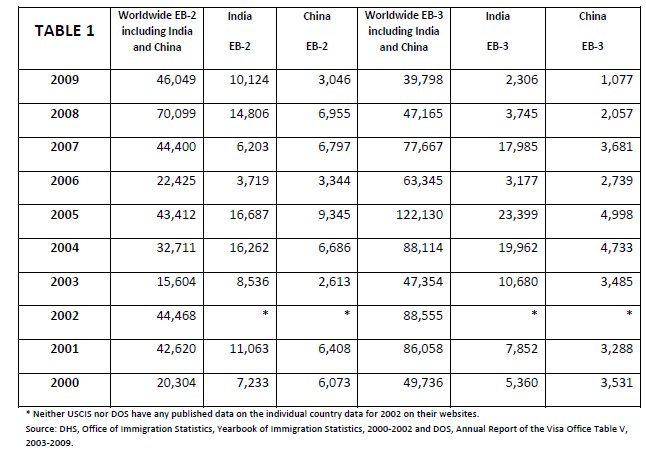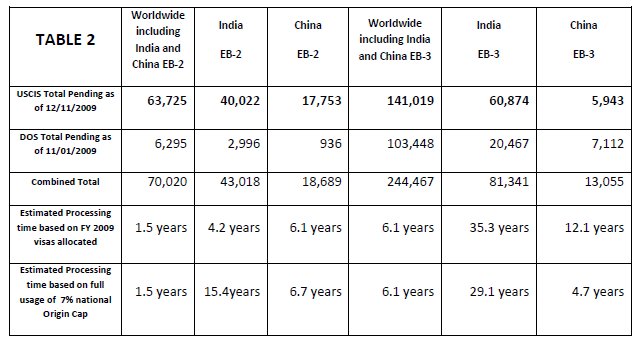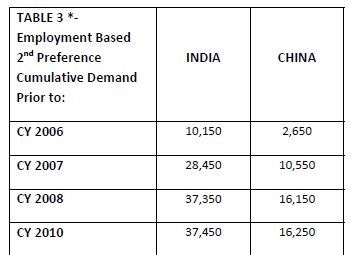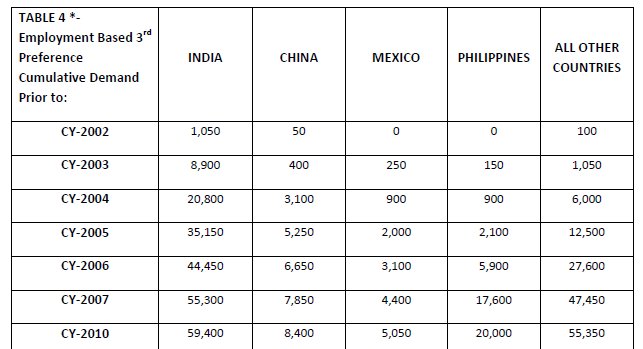United States immigration laws are preventing many of the most talented immigrants in the world from migrating to the United States. On January 10, 2010, the United States Citizenship and Immigration Services (USCIS) released new data confirming that some prospective highly skilled immigrants from one country – India – may have to wait as much as 35 years to get a green card, unless Congress takes steps to change the current nationality based visa quota system and increases the annual quota.
Under the Immigration and Nationality Act (INA), 140,0001 employment based immigrants, inclusive of spouses and children, may migrate to this country annually in one of five general categories.
First Preference Employment Based Immigrants (EB‐1) : This category is for Priority Workers and is limited to 40,000 visas each year (28.6% of the worldwide employment‐based preference level). Any unused visa numbers from the EB‐4 and EB‐5 categories may be added to this quota. 15, 184 workers and 21,494 spouses and children immigrated under this category in FY 2008, which is the latest available detailed data.
Second Preference Employment Based Immigrants (EB‐2): This category is for workers in professions holding advanced degrees or persons of exceptional ability. The number of visas available annually in this category are 40,000 (28.6% of the worldwide employment‐based preference level), plus any visas that are not used in the EB‐1 category. 34,535 workers and 35,511 spouses and children immigrated under this category in FY 2008.
Third Preference Employment Based Immigrants (EB‐3): This category is for skilled workers, professionals, and lesser skilled workers referred to as "other workers: The annual limit for workers in this category is 40,000 (28.6% of the worldwide employment‐based preference level), plus any visas that are not used in the EB‐2 category for that year. However, no more than 10,000 visas can be allocated to the lesser skilled "other workers" in this category. 20,596 workers and 28,303 spouses and children immigrated under this category in FY 2008.
Fourth Preference Employment Based Immigrants (EB‐4): This category is for certain special immigrants such as religious workers, certain long‐time employees of the U.S. government, citizens of Iraq or Afghanistan that have worked for the U.S. Armed Forces as a translator for at least 1 year, some physicians who have residence in the U.S. for a number of years, juvenile dependents of a court who are eligible for foster care, some dependents of diplomats and others . It is limited to a maximum of 10,000 visas per year (7.1% of the worldwide employment‐based preference level). 5,164 workers and 4,346 spouses and children immigrated under this category in FY 2008.
Fifth Preference Employment Based Immigrants (EB‐5): This category is for investor immigrants who create employment . It is limited to a maximum of 10,000 visas each year (7.1% of the worldwide employment‐based preference level). 427 workers and 922 spouses and children immigrated under this category in FY 2008.
The employment based categories are further restricted by country of nationality, and no more than 7 percent of each category can be allocated to any single nationality. Thus, no more than 2800 visas may be initially allocated to a single nationality group in each of the first three categories. Similarly, no more than 700 visas in each of the last two categories may be awarded to nationals of any single country.
This seemingly arbitrary across‐the‐board limitation has proven disproportionately disadvantageous to visa applicants from more densely populated countries. For example, under this formula, the maximum number of visas allotted to nationals of China and India, each with a population of over one billion citizens – is the same as that for nationals from smaller states such as Nauru with a population of 10,000 or even the Vatican, which has a population of only 800 citizens.
In recent years, there have been times when the total number of available visas in a particular category have not been entirely allocated. When this happens, these unused visas become available to oversubscribed countries such as India and China. The complex numerical allocation system cannot be fully explained here. The Department of State has a detailed explanation of this process at its website http://www.travel.state.gov/pdf/Immigrant%20Visa%20Control%20System_operation%20of.pdf . In 2000, Congress passed legislation which allowed the use of approximately 130,000 unused visas from the 1999 and 2000 fiscal years to be used in future years when the 140,000 annual limit was reached. This allowed additional visas to be issued in the EB‐2 and EB‐3 categories. The following chart shows the number of immigrant visas (green cards) allocated worldwide on an annual basis as well as the immigrant visas issued to Indian and Chinese nationals in the two categories that are oversubscribed – EB‐2 and EB‐3:

For the past seven years, in my role as the nation's first Citizenship and Immigration Services Ombudsman and subsequently as an immigration attorney in private practice, I have requested from USCIS the data on the total number of pending employment‐based cases by category, priority date, and country of chargeability. Common sense dictates that USCIS would maintain and monitor such statistics in the course of performing its core immigration functions. Without this data, USCIS would appear to be violating the very basis of the law that established the numerical limits on employment‐based immigrant visas. The responses to my queries have been disheartening at best.
In August 2009 USCIS released a report that, for the first time, publicly revealed some of this important data that I had been requesting since 2003. On January 10, 2010, USCIS released an updated version of the data. USCIS has acknowledged that it has not included all the data since its systems do not allow it to do so. The data excluded some pending cases for which visa petitions had not been approved, even though USCIS accepted the I‐485 applications concurrently. USCIS also excluded applications pending at field offices, which are apparently on a different database system, and excluded the pending cases with the Department of State's National Visa Center (NVC).
DOS recently released data on pending cases at the NVC. The combined data paint a bleak picture for EB‐2 and EB‐3 applicants. However, for Indian and Chinese nationals, the news is even worse.
The following chart shows total combined pending number of employment based visa applications pending at the two USCIS Service Centers based on the Jan 10, 2010 report as well as the number of employment based visa applications pending at the Department of State's National Visa Center:

As pointed out earlier, Table 2 reflects the estimated total number of pending applications for employment based immigrant visas based on the available data. USCIS has always insisted that the data from the two service centers reflects most of the applicants. However, in a strange twist of events, on January 28, 2010, the Department of State provided the author with data on visa requests from various USCIS offices including the two service centers. The data reveals that during the first four months of the fiscal year, USCIS service centers requested 4,200 employment based immigrant visas while district (field) offices requested 8,400 employment based immigrant visas. This suggests that field offices may have many more pending cases than USCIS has previously represented. If USCIS has a large number of employment based immigrant visa applications pending at the field offices, as indicated by the visa requests from field offices in the first four months of this fiscal year, the ominous predictions for the estimated number of years to process the EB‐2 and EB‐3 cases for India and China could rise dramatically.
On February 3, 2010, the Department of State released the current pool of visa applicants and documentarily qualified applicants for whom USCIS has already requested a visa number. The following charts, Tables 3 & 4, replicate the charts published by DOS and confirm the information provided above. It should be noted that this set of numbers includes all visa applicants waiting abroad and registered with the NVC and also includes a portion of the current pending applicants at USCIS Service Centers shown in Table 2 and some additional USCIS pending applicants at USCIS field offices. Unfortunately, neither USCIS nor DOS have been able to reconcile and account for the numbers reported by USCIS into the DOS database. For applicants, their lawyers, researchers and anyone else reviewing the data, including Congress, this situation presents an environment where there is no ability to hold the government agencies accountable for their actions or inactions in this area since data can be manipulated without regard to legislative requirements:

*See full report at http://www.travel.state.gov/pdf/EmploymentDemandUsedForCutOffDates.pdf

*See full report at http://www.travel.state.gov/pdf/EmploymentDemandUsedForCutOffDates.pdf
The data in Table 3 and Table 4 is used to set the monthly visa priority dates which is the official
The data in Table 3 and Table 4 is used to set the monthly visa priority dates which is the official process by which the visa quotas are allocated. The monthly Visa Bulletin and a more complete explanation of the Visa Bulletin can be accessed at www.state.gov .
Solution
The immediate solution is full accountability of all pending applicants for employment based immigrant visas both at USCIS and DOS. Without accurate data, it is difficult to hold the agencies accountable for their actions or inactions.
Another solution is to "recapture" lost visas. Between 1994 and 2006, USCIS underutilized the visa numbers by approving less than the 140,000 employment based applications each year even though USCIS had more than enough applications pending. Due to the statutory calculation method (explained more fully by USCIS and DOS on their websites), USCIS's failure to timely process a sufficient number of applications resulted in the loss of approximately 349,000 visa numbers that could not be used in future years since the law prevents usage in future years. In 2000, Congress authorized the use of 130,000 these "lost" visa numbers by what has come to be known as the "visa recapture" method. However, approximately 219,000 numbers have not been "recaptured". The current worldwide pending cases in all employment based categories is approximately 340,000 applicants. A one‐time recapture of the 219,000 unused visa numbers could go a long way to eliminating this backlog and bringing much needed relief to many applicants who currently face the prospect of becoming residents of the United States after they retire.
The most important solution is resolving the nationality based discrimination built into our immigration laws, especially with regards to attracting the "best and the brightest" talent regardless of nationality. Congress must act now to end this nationality‐based discrimination against would‐be immigrants. Stakeholders in this issue — including U.S. employers in need of highly skilled workers— should let their lawmakers know in this election year that such discrimination is no longer tolerable. It is time to remove this blemish from our immigration system.
It is imperative that lawmakers review these ominous statistics. Congress needs to take action to remedy this problem. The problem was caused in part by inefficiencies and lack of accountability at USCIS and its predecessor agency, the Immigration and Naturalization Service (INS); in part by the failure of two agencies, USCIS and DOS to cooperate and share data; and, in part by the national origin based discriminatory statute, which is having an unintended effect of preventing tens of thousands of the most talented individuals from equally competing for visas that should be given to those that this country most needs rather than by discriminating based on national origin.
Footnote
1 This 140,000 varies annually based on a complex formula of allocation of some unused visas from the family based quotas from the previous year. Additionally, between 2001 and 2006, legislation allowed the use of some unused employment based visa numbers ("recaptured") from the years 1999 and 2000, when the Immigration and Naturalization Service failed to process sufficient numbers of employment based applications to utilize the visa quota despite having a sufficient number of applications. Under a complex allocation formula specified in the statute, these unused visa numbers could not be used in future years until a law was passed allowing the "recapture" of these "lost" from fiscal years 1999 and 2000.
Prakash Khatri has a national Immigration Law practice based out
of Washington, DC. He has been practicing law for more than 25
years. He is a nationally recognized expert on Immigration law and
process. He is also the President and CEO of KPK Global Solutions,
LLC, a consulting firm specializing in strategic-level immigration
issues and is "of Counsel" to the Fakhoury Law
Group.
Copyright © Prakash Khatri, 2010. All rights reserved. No
portion of this can be reprinted without the express written
permission of the author.

